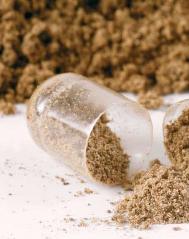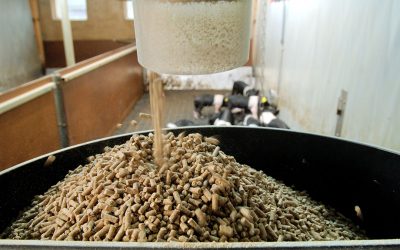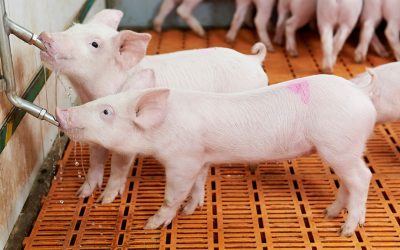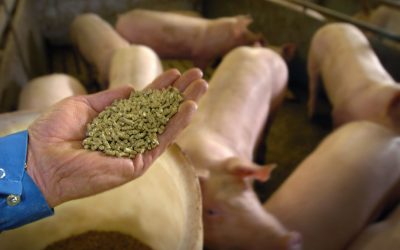Quick facts on cereal based carriers

Producers of food, feed and veterinary drugs make frequent use of carriers when adding flavourings, drugs, premixes or other micronutrients to their products. Feed Tech asked Meneba – Dutch producer of organic cereal based carriers – some basic facts on their use in animal feed.
By Emmy Koeleman
Micronutrients such as vitamins and minerals are often used in very low quantities in animal feed. This can make correct dosing a difficult task as it is easy to add too much of the product. In addition, these ingredients are often very expensive, so adding too much is not appreciated by the customer.
For optimising the dosing of these small quantities, feed producers therefore use carriers. Carriers can be organic or inorganic and will be attached to the ingredients. Inorganic carriers are made of silica or chalk. Organic carries are raw materials of which corn gluten feed, wheat bran and soybean meal are a few examples. The main advantages of organic carriers over inorganic carriers are that they also have nutritional value. Advantages of silica are that it has a large surface to which some ingredients might adhere. The advantage of chalk is its price; it is cheaper than all the other carriers.
(Photo Caption: Carries can be used for homogenously mixing micro-components in an end product, as diluting component, as an adhesive medium for components or to enhance free-flowing properties)
Application of carriers
Carriers can be used for homogenously mixing microcomponents in an end product, as diluting component, as an adhesive medium for components or to enhance free-flowing properties (no clogging in the tubes or silos). The choice of carrier depends on the properties you want your end product to have. One important aspect is how well it is mixed with the ingredients. This is affected by various factors such as particle size (granulation), structure, moisture content and bulk weight. When using a carrier to dilute an active substance, the particle size of the carrier must be similar to the active ingredients in order to ensure a good mix and dilution. When a carrier is used for adhesion purposes, the carrier particles must be bigger than the active substance. In all cases the particle size must remain within a small bandwidth to avoid segregation or separation. The granulation depends partly on the strength of the particles.
During production, transportation and storage, abrasion and fracturing can change the granulation. This can affect the bulk weight and the specific surface area of the carrier. Properties such as hardness, fall strength, bending strength and resistance to abrasion play an important role in achieving a consistent particle size.
Gelatinisation for better absorption
A carrier used as an adhesive medium must have adhesive strength to ensure good sticking of the additives and to enable heavy particles to be transported through the feed process. Cereal-based carriers are milled and have a fairly coarse surface structure to which components can easily adhere without affecting their free-flowing properties. Carriers are also important for liquid additives. One way to increase the absorbent capacity of the carrier is to gelatinise it. Carriers based on gelatinised wheat absorb both moisture and oil and are perfect for these (liquid) applications. Meneba uses various gelatinisation techniques in which moisture, temperature and pressure are applied to break down the crystal structure of the starch. This creates a spongy structure that contains a lot of capillaries and is highly absorbent. Depending on the extent of gelatinisation, up to 45% oil and 35% water can be introduced into the carrier. The use of these gelatinised carriers is more expensive than non-gelatinised carriers, and it therefore depends on the application and the client whether it is chosen.
Control of moisture content
Moisture affects a lot of factors. It can cause decay, clumping, breakdown of vitamins, reactions of various additives and reduce free-flowing properties. Meneba controls the moisture content and the AW value (Activity of Water value – the amount of free water in the product) of its carriers with heat treatments such as drying, extruding and the Presco® process. This patented process by Meneba is an acronym for pressure cooking, also called the HTST process (High Temperature, Short Treatment). The process reduces the original moisture content from 15% to 6% with a low AW value. These treatments and the low moisture content of the end product significantly reduce the microbiological values and growth of bacteria, moulds and yeasts, thus improving the shelf life of the end product. This also makes it possible to introduce higher doses of hygroscopic products and liquid additives into the carrier and avoids clumping in hygroscopic products. In the case of organic carriers, the Presco® process can thus be used to steer the humid and absorption capacity.
Bulk weight and colour
Differences in bulk weight are one of the main causes of separation. The bulk weight of the carrier and the microingredients should therefore be very similar. Combined with the right adhesion and granulation, this will produce a homogenous mix. The bulk weight must also be close to the tamped weight (bulk weight of a product after vibration) in order to prevent bridging. Meneba’s organic carriers have a bulk weight of between 300 and 700 grams/litre.
Like the granulation, the bulk weight can be optimised with various milling techniques and precisely matched to specific additives. The colour of the carrier affects the colour of the end product to a large extent. The colour spectrum of wheat flour, corn flour and branbased carriers ranges from bright white and cream to yellow and brown. The colour of the end product can therefore be controlled. Colour offers scope for differentiation, which can be important for products such as top dressings in the feed sector.
Free-flowing and dust formation
Cereal-based carriers are milled and have a fairly coarse surface structure which improves adhesion of components and enhances free-flowing properties. Along with particle size or granulation, the surface structure plays a key role in the carrier’s free-flowing properties. Meneba carriers are free-flowing. Problems such as bridging during storage, transportation or dosing do not occur. Carriers that form dust can pose a risk to the people working with the product and can cause separation and inadvertent contamination. By controlling the moisture content and granulation, the carriers are not particularly susceptible to dust formation.
Conclusion
Organic carriers are frequently used in the food and feed industry and have a lot of positive characteristics, such as good adhesion capacity, good absorption capacity, stable granulation in narrow bandwidths, excellent free-flowing properties and good microbiological properties. Whether you should chose for an organic or a inorganic carrier depends on the application and the end product.
For more information please go to www.meneba.com
Source: Feed Tech Magazine Volume 12. No. 9











